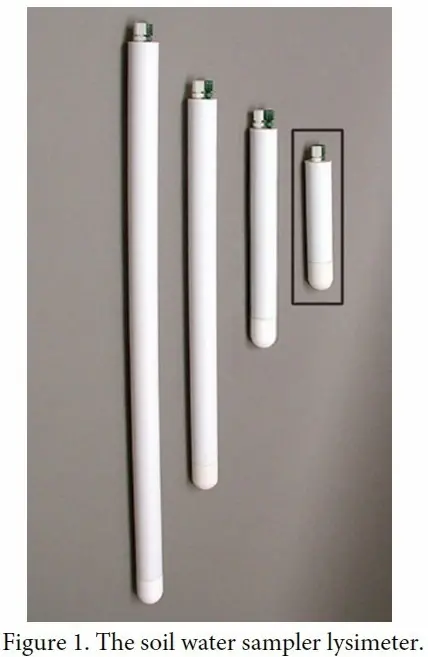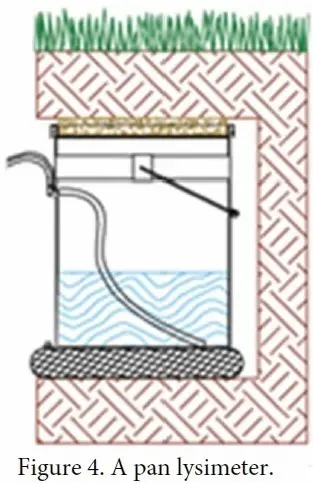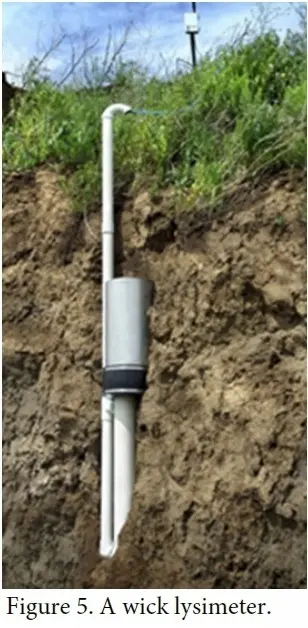Lysimeters: simple definition but complex in application
OVERVIEW
PRODUCTS
LOCATION
Sampling Lysimeter
The sampling lysimeter (Figure 1), also known as a pore water sampler, is an apparatus for the sampling of moisture from the soil. Moisture moves from the soil through a porous ceramic cup into some container for later collection. The movement of water occurs due to a vacuum being pulled on the ceramic cup. The sample is then taken to a lab for further chemical analysis. There are numerous types of sampling lysimeters depending on whether solution needs to be sampled close to the surface, deep in the profile, or if unique chemicals are involved.
The sampling lysimeter is used in ongoing monitoring applications such as testing beneath tailings dams, beneath crops, or even in soil column experiments in the lab. This type of lysimeter is best used on relatively moist soils typically with a maximum suction of -90kPa.
Soil Moisture Probe Lysimeter
The soil moisture probe lysimeter involves installing one or more volumetric water content sensors in a soil profile. The number of probes depends on soil depth and the depth to which moisture infiltration needs to be monitored.
This type of lysimeter is commonly used in applications such as phytocaps on disused landfills or mine sites where the integrity of the cap needs to be monitored.
In this case, if the cap is performing correctly, then there should be no change in volumetric water content. If, following a rainfall event, there is an increase in measurements at 10cm depth but not 30cm depth then moisture is infiltrating a short distance beneath the cap. If there is an increase value from all moisture probes then the cap is a failure. Engineers can then implement a management strategy to prevent further infiltration.
The soil moisture probe lysimeter can also be used in evapotranspiration modelling applications where drainage, storage, and even run off are important parameters in these types of models.
Another application is in soil columns experiments. A series of sensors can be installed down the vertical face of the soil column in order to measure and model moisture movement and storage.
Pan Lysimeter
The pan lysimeter (Figure 4) is also known as a zero tension lysimeter. This type of lysimeter is rather crude and can easily be manufactured in the backyard. A pan-like container, typically a bucket, is filled with coarse material such as gravel. This sits in the soil profile beneath an area of interest, for example a crop or turf. Water drains through the coarse material into some collection device. The amount of water in this collection device is either manually or automatically measured with a water depth sensor.
The pan lysimeter appears to be a simple device, particularly when compared with a weighing lysimeter. However, it can be highly inaccurate. Due to soil physics and issues associated with water potential gradients, a large amount of soil moisture can be diverted away from the pan lysimeter and is never measured. This particular apparatus should only be considered when budgets are extremely limited.
Wick Lysimeter
The wick lysimeter (Figure 5), also known as a fixed tension lysimeter or passive capillary lysimeter, is an advanced and highly accurate type of pan lysimeter. In this case a wicking material, such as fibreglass, maintains a fixed tension at the drainage interface with the collection device. A divergence control “tube” is installed above the wick for greater accuracy. This tube is usually a stainless steel pipe about 1m in length. Back-fill or an intact soil profile is placed within the tube. Similarly with the pan lysimeter, a wick lysimeter is placed in the drainage zone beneath the root zone of the target plant.
Tipping buckets or water level sensors can measure the amount of water passing through the wick and a drainage rate can be determined. With some designs, the water can also be collected for nutrient or chemical analysis.
The wick lysimeter is typically installed under crops, turf or some other plant of interest. It can also be used in other applications, such as monitoring drainage beneath a tailings dam or phytocap.




